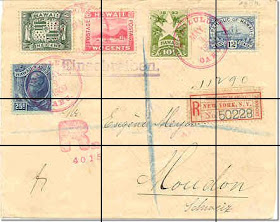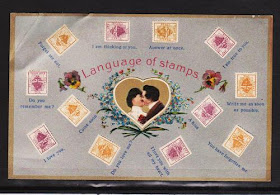Now, this secret language was usually as secret as the Language of Flowers... that is, most people understood it.
This code language was based on how the stamp was situated compared to the name of the receiver, and the angle of the stamp.
Some languages only used the angle, and it didn't matter where on the letter the stamp was.
There were also more complex system developed. Some used the color of the stamps, in some versions it mattered whether you used one stamp or two, some gave different meaning to stamps from different countries!
There are 8 sections of a letter. Nine, if you count in the name section. Above the name, right upper corner, right side of the name, right lower corner, under the name, left lower corner, left of the name and left upper corner. One can place the stamps in any of these corners - or could, when the letters were stamped by hand.
Now, straight above and under the name are sometimes counted as belonging to upper right/left or lower right/left.
Usually it's enough to place the stamps upright or upside down. The simple interpretation is "yes" and "no".
(This is a Bulgarian stamp. It's very pretty and one can see clearly how it is turned)
But then there was a need for more positions...

Slightly tilted, left, right, upside down... It really wasn't intended to be accurate measures, just the points of the compass (4, 8 or 16). One could also use the clock face.
Sometimes the meaning was the total opposite from one system to another, so it was important that the lovers used the same code. These codes were sold as post cards or small leaflets for more complex codes, and it was thought that the person bought two copies of the code, and gave the other to his/her lover.
Here's a lot of examples of different codes in different languages
Here's more, in French and here's another
Here's a translation of a Swedish card from 1902
Here's a lovely article about this
So - what I suggest you do is to create your own system together with your friend, and see that you keep the code key somewhere where others can't find it, but where you will... you wouldn't want to forget your own key :-D
I also suggest you forget all about color coding your language, as the stamps of today are most often printed in many colors.







No comments:
Post a Comment